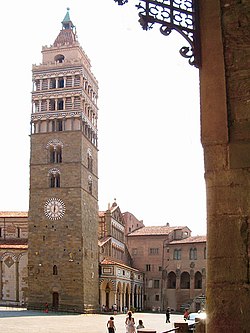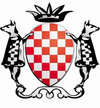Pistoia
| Pistoia | ||
|---|---|---|
| Comune | ||
| Città di Pistoia | ||

The bell tower of the cathedral in Piazza Duomo
|
||
|
||
 Pistoia within the Province of Pistoia |
||
| Location of Pistoia in Italy | ||
| Coordinates: 43°56′N 10°55′E / 43.933°N 10.917°ECoordinates: 43°56′N 10°55′E / 43.933°N 10.917°E | ||
| Country | Italy | |
| Region | Tuscany | |
| Province / Metropolitan city | Pistoia (PT) | |
| Frazioni | see list | |
| Government | ||
| • Mayor | Samuele Bertinelli (PD) | |
| Area | ||
| • Total | 236.17 km2 (91.19 sq mi) | |
| Elevation | 65 m (213 ft) | |
| Population (31 July 2013) | ||
| • Total | 90,462 | |
| • Density | 380/km2 (990/sq mi) | |
| Demonym(s) | Pistoiesi | |
| Time zone | CET (UTC+1) | |
| • Summer (DST) | CEST (UTC+2) | |
| Postal code | 51100 | |
| Dialing code | 0573 | |
| Patron saint | St. Jacopo | |
| Saint day | July 25 | |
| Website | Official website | |
Pistoia (Italian pronunciation: [piˈstoːja]) is a city and comune in the Italian region of Tuscany, the capital of a province of the same name, located about 30 kilometres (19 mi) west and north of Florence and is crossed by the Ombrone Pistoiese, a tributary of the River Arno. It is a typical Italian medieval city, and it attracts many tourists, especially in the summer.
Pistoria (in Latin other possible spellings are Pistorium or Pistoriae) was a centre of Gallic, Ligurian and Etruscan settlements before becoming a Roman colony in the 6th century BC, along the important road Via Cassia: in 62 BC the demagogue Catiline and his fellow conspirators were slain nearby. From the 5th century the city was a bishopric, and during the Lombardic kingdom it was a royal city and had several privileges. Pistoia's most splendid age began in 1177 when it proclaimed itself a free commune: in the following years it became an important political centre, erecting walls and several public and religious buildings.
In 1254 the taking of Ghibelline Pistoia by Guelph Florence, was among the origins of the division of the Florentine Guelphs into "Black" and "White" factions. Pistoia remained a Florentine holding except for a brief period in the 14th century, when Castruccio Castracani captured it for Lucca, and was officially annexed to Florence in 1530. During the 14th century Ormanno Tedici was one of the Lords of the city. Dante mentioned in his Divina Commedia the free town of Pistoia as the home town of Vanni Fucci, who is encountered in Inferno tangled up in a knot of snakes while cursing God.
...
Wikipedia


